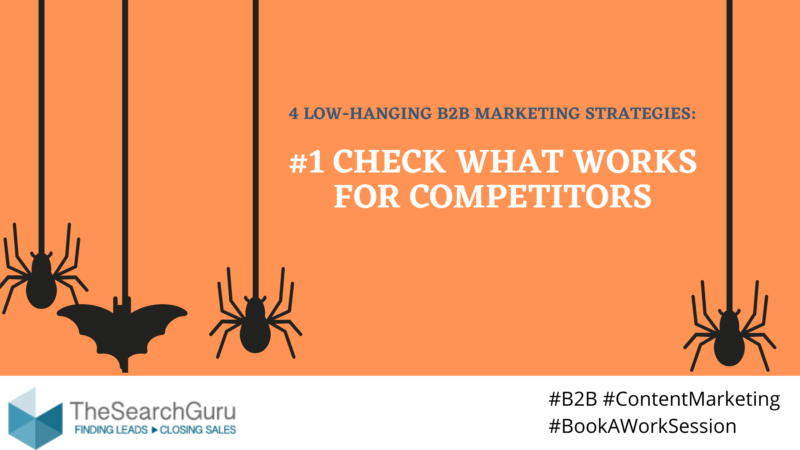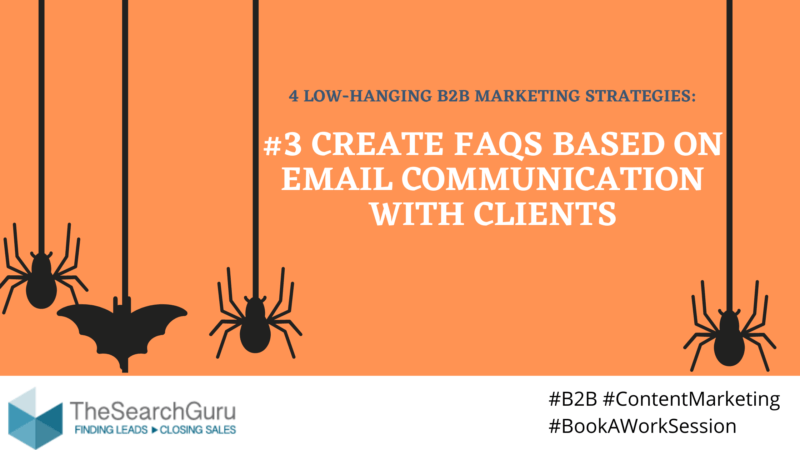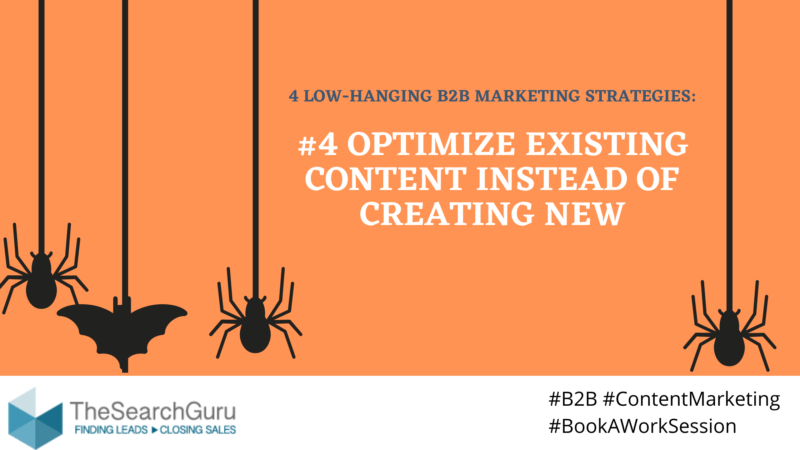For over 12 months now TheSearchGuru’s team has provided free work sessions to b2b marketers. The curious thing… the top marketers we’ve spoken with have all had one thing in common — they all have to produce results, but have limited resources.
So, that’s what we’ve focused on — finding working solutions for producing results with scarce resources.
This article is for you if you need more:
- budget
- people
- time
- support
And, this article is for you if:
- You are a B2B company with a long and complicated sales cycle.
- You need more leads from your digital marketing channels.
- You develop content, but you are not sure what’s not working and where to start fixing it.
Now, let’s have a look at the top strategies we’ve identified as the easiest to implement when resources are limited:
- #1 Start right / prioritize correctly: Check what works for competitors
- #2 Win backlinks and build your Domain Authority (DA): Reach out to partners
- #3 Content Optimization: Create FAQs based on email communication with clients
- #4 Build Targeted Traffic: Optimize existing pages instead of creating new ones

#1 Check what works for competitors
This is a preferred tactic for the majority of marketers we’ve worked with. There are tools like SEMrush that show you where competitors’ websites get their search traffic – an excellent starting point for your content strategy.
- Which topics do competitors target that wouldn’t be hard to rank for (e.g. with low keyword difficulty)?
- Are they targeting top of funnel or bottom of funnel topics?
- What made their content rank well in the search results?
- Which keywords are they investing in in Paid Search campaigns (Google Ads)?
- Which sites have chosen to link to competitors and what they have linked to, that might help us with our link building endeavors?
Check out this video for more on this (This was the 3rd of 3 sessions we did with ANA Philadelphia, where we dug into competitor analysis: top content, competitor keywords, competitor backlinks and more.).
If you’re unsure where to start from to research competitors, feel free to use our Competitor Audit template:

#2 Reach out to partners to get backlinks
We’ve spoken with big companies, we mean established businesses, some operating globally for over 30-40 years. They were doing business mostly through trade shows and over the phone. And their website was a brochure, serving as an online product catalog only.
At some point these companies realized they needed to do more about their online presence. And leveraging their established operations is a HUGE opportunity.
They usually have 50+ partners they do regular business with. Reaching out to them to just include a paragraph and a backlink about their brand would make a nice quick difference for their domain authority (DA) and rankings!
If you are in a similar position, consider connecting with partners and getting website references to improve your domain rank.

#3 Create FAQs based on email communication with clients
Question and Answer sections are very helpful in the digital world. People often are unclear about many aspects of your business and services, and are coming online to learn more about it.
Chances are you already know what these questions are, because you’ve answered them time and time again over the years on the phone or via email. Just grab this gold, polish it up and it might just become the best content on your product/service pages.
Find more about FAQs and search engine optimization here.

#4 Optimize existing content instead of creating new
Let me tell you, if FAQ content is gold, this one is a diamond. Do you know that you probably have pages ranking in Google for the keywords you want to target, but they are just not ranking high enough?
For the majority of websites the keyword ranking distribution looks something like this — over 85% of the keywords are on page 3 and lower in Google search results:

Source: SEMrush.com
Is there anything you can do about it? Definitely:
Step 1: Analyze the low-hanging keywords opportunities — these are keywords that rank positions 11 to 30 in Google search results.
Step 2: Arrange those keywords by search volume to see which keywords are the biggest opportunities.
Step 2.1: Another option to prioritize keywords is to go after lower in volume, but higher in sales intent terms, where the keyword difficulty is lower (Keyword difficulty in SEMRush is a metric of 1-100, which shows the competition levels for a keyword, 100 meaning extremely competitive, and hard to get in the search results.)
Step 3: Analyze the terms and choose the ones important for your business.
Step 4: See which page is ranking for the chosen terms and optimize the content for better search engine rankings:
- Check the pages currently ranking for the term
- See if there are sections and information your page is lacking
- Find questions people search with, around the topic
- Make changes on your page to improve that page’s content, based on these findings
- Try to build backlinks to the page (internal and external)
We call this the Content Optimization Process and, as our gift to you, here is a great template you can follow to help you.
Let’s work on this together: book a free work session
All companies we speak with have unique problems, and we’ve yet to find anyone who isn’t primarily plagued by too few resources. Take us up on a free training/work session where we can discuss your unique problems and offer solutions from top B2B marketers. Book one here:






